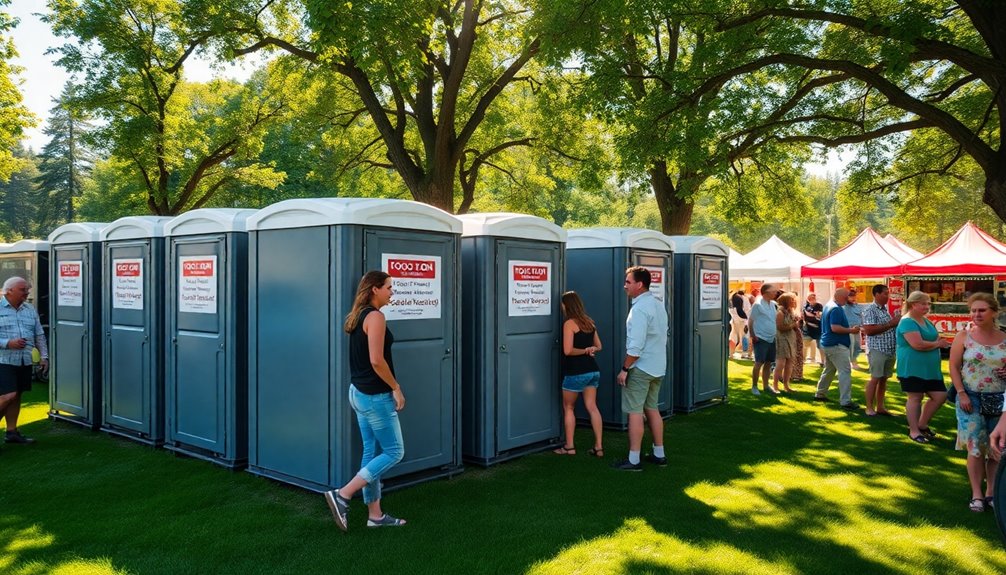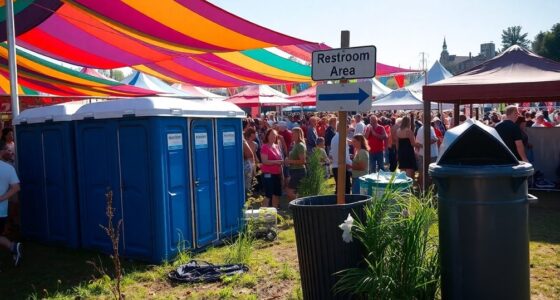Understanding local regulations for portable restroom installations at events is essential for your compliance and public health. You'll need permits if your gathering exceeds 50 attendees. Make certain to provide accessible units, with at least one for every 20 restrooms. Regular maintenance and sanitation are key to meeting health codes and keeping your attendees satisfied. Want to guarantee a successful event? There's more to discover about best practices and other requirements!
Key Takeaways
- Ensure compliance with local health codes to avoid violations and fines for portable restrooms at events.
- Obtain necessary permits for events with 50 or more attendees, especially if impacting public areas.
- Provide at least one accessible restroom for every 20 units, ensuring proper design for individuals with disabilities.
- Regularly clean and maintain restrooms according to health regulations, including timely waste tank emptying.
- Position restrooms at least 100 feet from food areas and ensure clear signage for visibility and access.
Importance of Compliance With Local Regulations
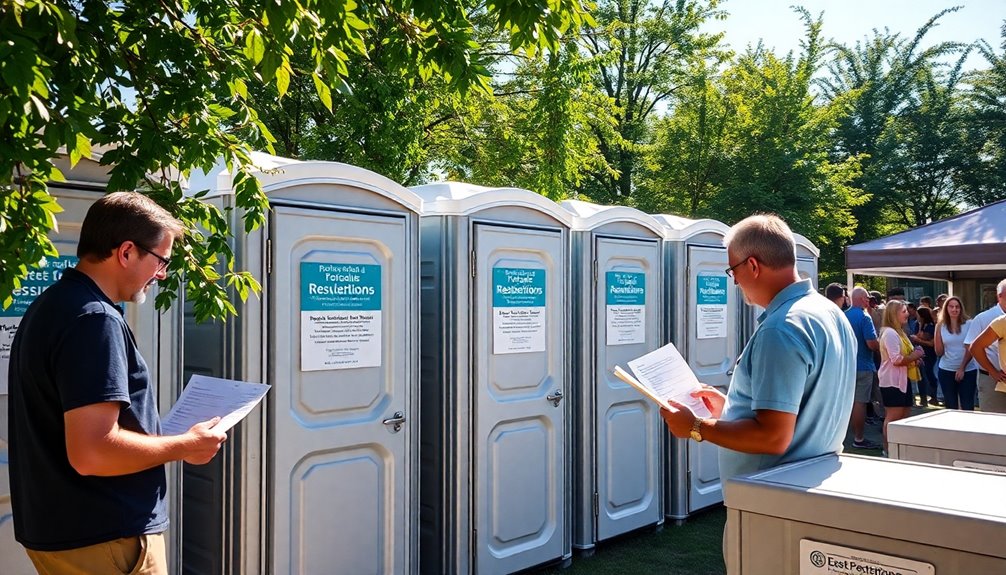
When you're planning an event, understanding the importance of compliance with local regulations is vital. Adhering to these regulations guarantees your portable restrooms meet health codes, minimizing the risk of violations and potential fines.
Many cities require permits for events with over 50 attendees, which include provisions for the minimum number of restrooms based on your crowd size. For larger gatherings, OSHA guidelines suggest one toilet for every 40 workers.
Plus, you must consider accessible restrooms; having at least one wheelchair-accessible unit is essential for guests with disabilities. By prioritizing compliance, you enhance the safety and comfort of your attendees, ultimately contributing to your event's success and positive reputation within the community.
Key Permits and Approvals Required for Events

Securing the right permits and approvals is essential for hosting a successful event, especially when it involves portable restrooms. For outdoor events with 50 or more attendees, you typically need a permit to guarantee sanitation standards and safety measures are met.
If your event impacts public streets or includes large structures like tents, additional permits will be necessary. Don't forget about noise regulations; using sound equipment might require a separate permit.
Also, if you plan to serve significant food and beverages, be aware of local health regulations that could trigger more permitting requirements.
Collaborating with event coordinators can streamline the process, assuring your restroom facilities meet all local requirements and provide accessible facilities for everyone.
Accessibility Standards for Portable Restrooms
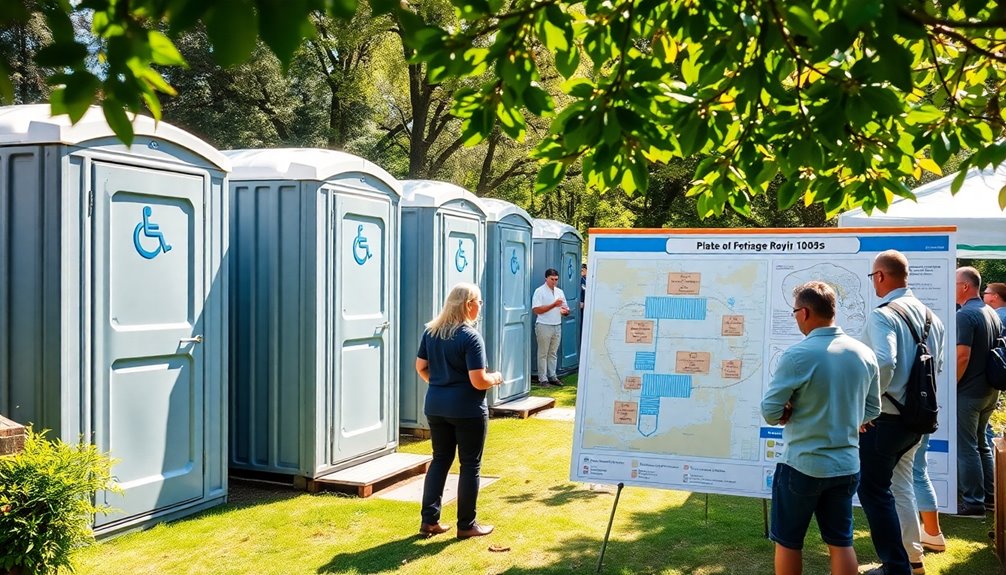
Ensuring that all attendees have access to necessary facilities is essential for any event, especially those with portable restrooms. Meeting accessibility standards isn't just a guideline; it's a requirement.
Here's what you need to know:
- At least one wheelchair accessible restroom is mandated for events with handicapped attendees.
- A general rule is one accessible unit for every 20 restrooms provided.
- Accessible restrooms should have wider entrances and grab bars for safety.
- Sufficient interior space is critical for maneuverability.
- Easy-to-use locks and clear signage enhance usability for individuals with disabilities.
Sanitation and Maintenance Requirements

To maintain a safe and hygienic environment at events, portable restrooms must adhere to strict sanitation and maintenance requirements. Regular cleaning and sanitizing according to established schedules guarantees user hygiene and comfort. Waste tanks need to be emptied in compliance with local health regulations to prevent overflow. Additionally, maintaining the structural integrity of these toilets is vital for user safety; any damages should be repaired promptly. Hygiene practices include installing handwashing stations with running water, soap, and drying means. Compliance with sanitation standards also involves pest control measures to prevent infestations in portable restrooms.
| Requirement | Description |
|---|---|
| Regular Cleaning | Scheduled sanitization of restrooms |
| Waste Tank Management | Timely emptying to prevent overflow |
| Structural Integrity | Repair damages immediately |
| Hand Washing Stations | Provide soap, water, and drying options |
| Pest Control Measures | Implement to prevent infestations |
Best Practices for Portable Restroom Placement
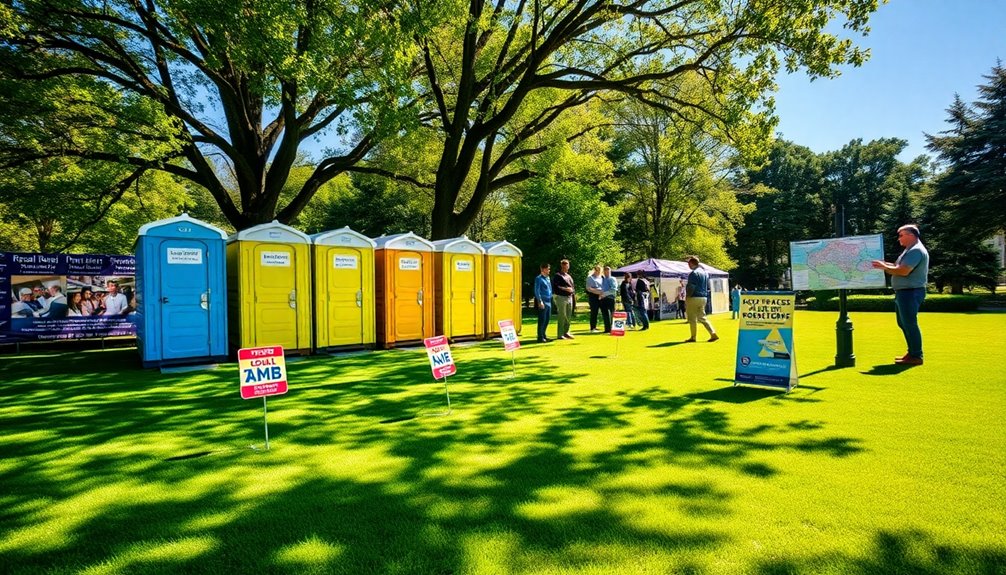
When planning the placement of portable restrooms, it's crucial to take into account factors that enhance user convenience and safety.
Here are some best practices to guarantee hygiene and comfort for all attendees:
- Position toilets at least 100 feet away from food preparation areas to comply with local regulations.
- Confirm facilities are on level, stable ground to prevent tipping and accommodate accessible access.
- Make units visible and use clear signage to guide attendees, reducing confusion.
- For events longer than four hours, scatter restrooms across the venue to meet event needs.
- Place units near service access routes for regular servicing, confirming proper ventilation and maintenance.
Frequently Asked Questions
How Many Portable Restrooms Do I Need for an Event?
To determine how many portable restrooms you need for your event, start by estimating your guest count.
Generally, plan for one unit per 50-100 attendees for short events. If you expect over 200 guests, follow OSHA's guideline of one toilet and urinal per 50 workers.
Don't forget to factor in the male-to-female ratio and the impact of alcohol consumption, as both can increase restroom usage considerably.
Adjust your numbers accordingly for comfort!
What Are the Rules for Portable Toilets?
When it comes to portable toilets, you'll need to know a few key rules.
For events with over 50 attendees, a permit is often necessary. OSHA requires at least one toilet for up to 20 people, adding one more for every 40 additional attendees.
If you have guests with disabilities, guarantee at least one accessible unit is available.
Regular cleaning and maintenance are essential to meet health standards and keep everyone satisfied.
What Is the OSHA Rule for Portable Toilets?
Imagine hosting an event without adequate restroom facilities—chaos, right?
OSHA requires you to provide one portable toilet for every 20 workers at smaller gatherings. For larger events, it's one for every 40 attendees, with specific ratios for over 200 guests.
You must also guarantee at least one unit is wheelchair accessible if needed.
Regular cleaning is non-negotiable to maintain sanitary conditions, enhancing comfort and safety for everyone involved.
How Many Portable Toilets for an Event?
When planning your event, you'll want to calculate how many portable toilets you need based on your expected attendance.
For gatherings under 20, one toilet suffices, but for larger events, provide one toilet seat and one urinal for every 40 attendees.
If you have over 200 guests, it's one for every 50.
Don't forget to take into account the male-to-female ratio and include at least one wheelchair-accessible restroom for inclusivity.
Conclusion
Maneuvering through local regulations for portable restroom installations is essential for your event’s success. Just like a well-tuned orchestra, every detail needs to harmonize to create a seamless experience for your guests. By understanding the necessary permits, accessibility standards, and maintenance requirements, you not only guarantee compliance but also provide comfort and convenience. Remember, taking these steps will make your event memorable for all the right reasons, so don’t overlook the importance of planning ahead! Additionally, it’s crucial to communicate with your portable restroom provider to ensure they are aware of any local guidelines and can help you navigate the process effectively. Failing to address these details can lead to common mistakes in event planning, such as underestimating the number of units required or neglecting to provide adequate sanitation options for guests with disabilities. By prioritizing these logistical aspects, you can focus on creating unforgettable experiences that leave a lasting impression.
